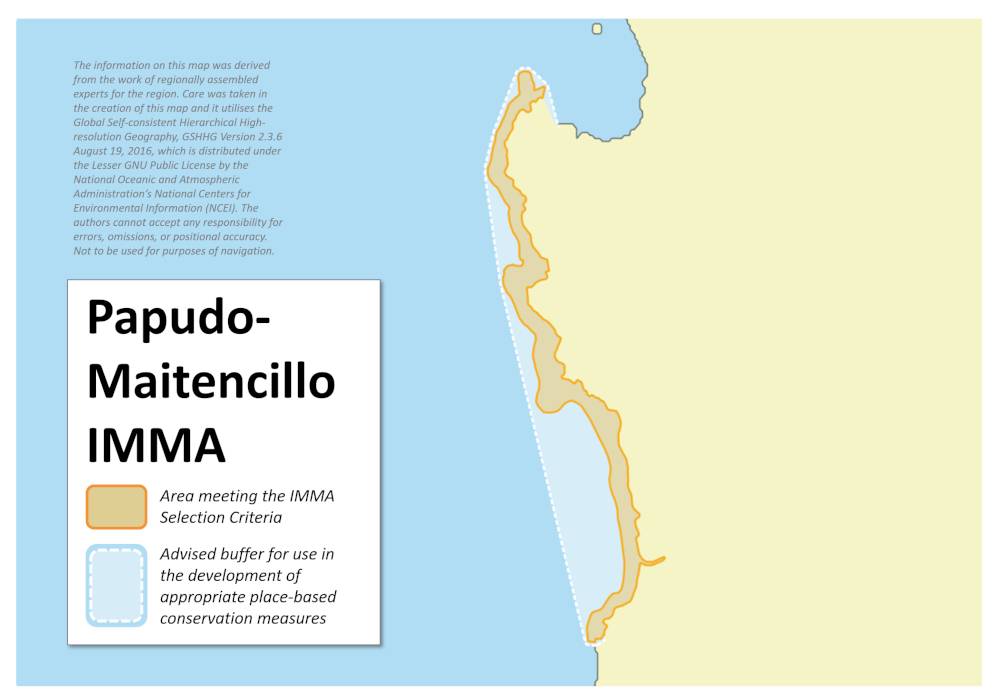Papudo-Maitencillo IMMA
Size in Square Kilometres
12 km2
Qualifying Species and Criteria
Marine otter – Lontra felina
Criterion A; B (2)
Marine Mammal Diversity
Grampus griseus, Otaria byronia
Download fact sheet
Summary
The Papudo-Maitencillo IMMA is located near a coastal upwelling zone that generates high primary productivity. This area is composed of a portion of coastline on the mainland and the protected Cachagua Island. This area is justified for its importance to the marine otter (Lontra felina), which is Endangered (EN) on the IUCN Red List of Threatened Species, as well as under domestic Chilean Regulation. Isla Cachagua hosts the highest density of otters in central Chile and is therefore important habitat for the species. The marine otter is expected to decline in the future due to habitat loss and other threats. There are few protection measures in place for marine otters in Chile.
Description of Qualifying Criteria
Criterion A – Species or Population Vulnerability
The marine otter is classified as Endangered (EN) on the IUCN Red List of endangered species (Valqui and Rheingantz, 2021) and also by the Chilean Regulation for the classification of the wild species in Conservation categories (clasificacionespecies.mma.gob.cl) on the basis of inferred future population decline due to habitat loss and other threats (Valqui and Rheingantz, 2021). In Chile, this species is subject to several threats including habitat loss, bycatch in artisanal fisheries and lethal attacks by dogs. Habitat loss in particular has fragmented otter populations (Medina-Vogel et al., 2008; Vianna et al., 2010). More than 30 dead marine otters have been found in the IMMA in the last ten years, most of them killed by dogs or with other evidence of trauma (Frederick Toro, Pers.Comm). Presently there is very little enforcement of the measures to protect marine otters in the area of Papudo-Maitencillo.
Criterion B: Distribution and Abundance
Sub-criterion B2: Aggregations
The islands of Cachagua and the Quirilluca coastline have the highest densities of marine otters in the IMMA (Oliva et al., 2016). The greatest concentration of otters is in the vicinity of the Isla Cachagua (Oliva et al., 2016). However, the mainland coast opposite Cachagua Island also seems to represent an important habitat for this species (Gutiérrez et al., 2019). Since the home range described for this species is less than 4.5 km, the species will most likely be resident in the IMMA (Medina et al., 2007). An average density of 2.8 – 0.5 marine otters per km (range : 2.0 – 3.5 ind/km) has been estimated in the IMMA (Javier, Trivelli, and Chinchimen, unpublished data).
Supporting Information
Gutiérrez, L., Vargas, F., Pinto, P.,Troncoso, W., Santos-Carvallo, M. and Sepúlveda, M. 2019. ‘Impact of human activity on area use and activity patterns of the marine otter (Lontra felina) in central Chile’. Latin American Journal of Aquatic Research 47(1),122-128.
Medina-Vogel, G., Boher, F., Flores, G., Santibañez, A., and Soto-Azat, C. 2007. ‘Spacing behavior of marine otters (Lontra felina) in relation to land refuges and fishery waste in central Chile’. Journal of Mammalogy, 88(2), 487-494.
Medina-Vogel, G., Merino, L., Monsalve, R. and Vianna, J. 2008. ‘Coastal-marine discontinuities, critical patch size and isolation: implications for marine otter conservation’. Animal Conservation, 11 57-64.
Oliva, D., L. R. Durán, M. Santos, M.J. Pérez, L. Muñoz, R. Quiroz, M. Sepúlveda, L. Gutierrez, F. Vargas, T. Martínez, M. Flores, M. Daigie and P. Arce. 2016. ‘Determinación de los impactos en los recursos hidrobiológicos y en los ecosistemas marinos presentes en el área de influencia del derrame de hidrocarburo de Bahía Quintero, V Región, Monitoreo de mamíferos y aves marinas’. Informe Final Proyecto IFOP Subsecretaría de Pesca y Acuicultura. 124 pp.
Rutllant, J. and Montecino, V. 2002. ‘Multiscale upwelling forcing cycles and biological response off north-central Chile’. Revista Chilena de Historia Natural, 75(217), e231
Valqui, J. & Rheingantz, M.L. 2021. Lontra felina. The IUCN Red List of Threatened Species 2021: e.T12303A95970132.
Vianna, J.A., Ayerdi, P., Medina-Vogel, G., Mangel, J.C., Zeballos, H., Apaza, M. and Faugeron, S. 2010. ‘Phylogeography of the marine otter (Lontra felina): historical and contemporary factors determining its distribution’. Journal of Heredity, 101(6), 676-689.


